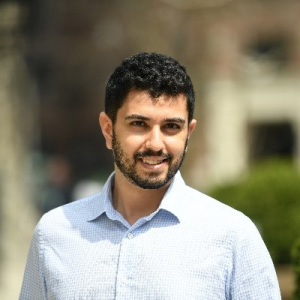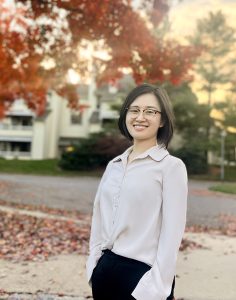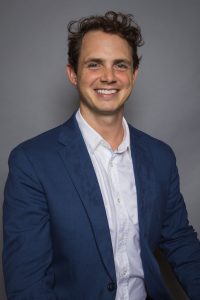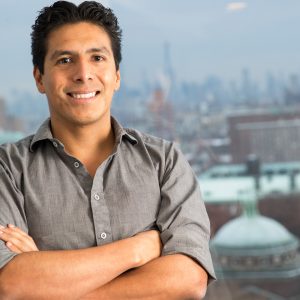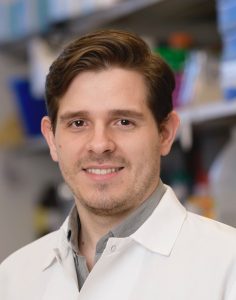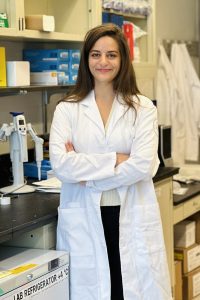Please welcome our Revson Fellowship class of 2022-2024!
Alvaro Curiel Garcia– Columbia University Medical Center
I got my BSc in Biology and Biochemistry at the University of Navarra (Spain). After studying a MSc in biomedical research at the University of Valladolid (Spain), I received my PhD working in the group of brain tumors at the Spanish National Cancer Research Centre (CNIO) studying the mechanism of chemoresistance and developing new murine models for glioblastoma using different genetic editing tools. My research in the laboratory of Ken Olive is focused on modeling PDA tumors as well as the study of novel therapeutic approaches useful for pancreatic patients. In my free time, I also love playing soccer, traveling as much as I can and spending time with my friends.
“Why did you want to become a scientist and when did you know this was your path in life?”
I decided to be a scientist because family members and relatives of friends suffered from cancer when I was young. I am very interested in understanding how it works – although cancer is actually more than 200 diseases – as well as looking for new treatments to help patients. I am lucky to be able to work on what I am passionate about and to this day I am still excited about that result, which could be the beginning of something that could change the paradigm in the way of understanding or treating pancreatic cancer.
Community Service:
I am also a volunteer in the NPO ECUSA, the Spanish Scientists in the USA. I am the chair of the Career Development Commission and member of the Executive Board Team.
Yujiao Han– Princeton University
Dr. Han is working toward understanding the contribution of the bone marrow microenvironment to cancer metastasis. She received a B.S. in Basic Pharmacy from China Pharmaceutical University and then received her Ph.D. in Biochemistry and Molecular Biology from Shanghai Institute of Biochemistry and Cell Biology, Chinese Academy of Sciences.
“Why did you want to become a scientist and when did you know this was your path in life?”
It was in a cell biology class in college, the chapter on cell-cell communication. I was shocked that cells work so hard to stay alive. The mechanisms of adaptation and self-regulation are so brilliant. With the advances in sequencing and imaging technology over the past decade, it’s time to understand cells, specifically the evil but smart tumor cells. If there’s a way to do that, if I can, then why not?
Ariel Edward Hight– New York University Grossman School of Medicine
I study sensory neuroplasticity in Rats and Humans with Cochlear Implants (CI). The CI is an auditory neuroprosthesis that restores auditory sensation to the deafened ear by sending electrical currents directly to auditory nerve, mimicking the patterns of activity in the healthy ear. Upon hearing with the CI for the first time, however, human subjects report significantly distorted sound compared to later time points. Learning to hear the CI requires a rehabilitation period and is proposed to require plasticity within the central auditory system, e.g. via changes to synaptic transmission and neural circuits. I am interested in how neuroplasticity enables speech comprehension despite significantly distorted cues provided by the CI. I received my PhD from Harvard University working under Dan Polley focusing on compensatory plasticity in the Auditory Cortex following noise-induced high-frequency hearing loss.
“Why did you want to become a scientist and when did you know this was your path in life?”
Since a very young age, I remember being one to incessantly ask questions. Like that kid who asks a few too many times, “but, why?!” Clues for why I wanted to become a scientist might be found during my childhood, but my career path like many others was full of detours. Based on early exposures during high school, my first passion and consequently my early training was in engineering. Ultimately, though, the flame to question even our deep assumptions lurked. With some fortuitous mentorship and support that flame was rekindled and set me on a path toward completing a PhD program in Neuroscience. Today, the flame continues to be fed as I trek towards becoming an independent scientist, one that leverages the technical skills associated with neural implant engineering to study the basic science of neuroplasticity, which is a nod toward my inner kid and the detours he took to get here.
Jesús Pérez-Ortega– Columbia University
Dr. Pérez-Ortega is an engineer and neuroscientist specialized in the analysis of neuronal ensembles and how these neurons work together in order to represent our thoughts, perceptions, and memories. He received a B.Eng. in Mechatronics and his Ph.D. in Neuroscience from The National Autonomous University of Mexico (UNAM).
“Why did you want to become a scientist and when did you know this was your path in life?”
I have loved problem-solving ever since I was little, specifically those that dealt with mathematics and natural sciences. I learnt how to build robots during my Bachelor studies, but I wanted to develop brain-computer interface technology. I decided to study brain signals and began my Ph.D. in Neuroscience. However, during this period, my curiosity about how the brain works increased so much that it fueled my motivation to develop science, and, as a result, I realized I wanted to become a neuroscientist.
Rodrigo Romero– Memorial Sloan Kettering Cancer Center
Dr. Romero’s research explores the biological processes underlying the cell state changes that occur in prostate tumors by employing genetically engineered mouse models and organoid culture in combination with single cell techniques. He received his B.S. in Biology from Suffolk University and later received his PhD in Biology from the Massachusetts Institute of Technology.
“Why did you want to become a scientist and when did you know this was your path in life?”
From a young age I was obsessed with animals. I collected “Wild Life” animal pamphlets and was glued to them when the new issue arrived in the mail. It wasn’t until High School where my obsession swapped from macroscopic to microscopic after learning of my aunt’s cancer diagnosis. Upon diving into cancer research as a post baccalaureate in Novartis, I truly began to appreciate the thrill of discovery and the need to advance patient care. I am continuously motivated by the strength and resilience of cancer patients I have met throughout my life, and these interactions remind me that experiments performed on the bench today can improve their quality of life tomorrow.
Cristina Santarossa– New York University Grossman School of Medicine
I was born and raised in Miami, FL, and then moved to western Massachusetts to attend Smith College, where I majored in chemistry. To prepare for graduate studies in the biomedical sciences, I completed a two-year postbac training program at the NIH, where I used mouse models to understand how the strength of TCR signaling dictates the fate of developing T-cells. For my PhD training, I joined Tarun Kapoor’s lab at The Rockefeller University. Under the mentorship of Prof. Kapoor, I helped develop a small molecule inhibitor of dynein, and then used structural and biochemical approaches to identify the compound’s binding sites and its mechanism of inhibition. For my post-doctoral training, I joined the labs of Damian Ekiert and Gira Bhabha at the New York University School of Medicine, where I am studying the structure and function of large and complex transporters that are involved in maintaining the outer membrane of Gram-negative bacteria.
“Why did you want to become a scientist and when did you know this was your path in life?”
Since childhood, I have been fascinated by how the ingredients of life come together to form complex organisms. Yet, until I went to college, I thought that I wanted to pursue a career in medicine, as I had never been exposed to other STEM opportunities. During college, my chemistry professor offered me a position in her lab and I then experienced the exhilaration of scientific discovery by studying how surface chemistry affects biofilm formation. Due to this experience and the encouragement from my mentor, I decided to pursue a career in science.
Community Service:
In addition to my research, I am dedicated to promoting equity in the scientific community. I participated heavily in conceptualizing and executing a Science Immersion and Long-term Mentoring program (NYU-SIP) for Queensborough Community College (QCC) students, the majority of whom are minorities, first generation college students, and from low income backgrounds. I am leading the year-long mentoring phase of the program, which provides each student with an advocate and support system to facilitate their transition to a four-year college or STEM position.
Leslie Weber– Memorial Sloan Kettering Cancer Center
Dr. Weber’s work uses functional genetics and stem cell-based approaches to study the molecular determinants of microglia metabolism, in the context of neurodegenerative disorders. In Dr. Geissmann lab, she uses iPSC-based models and gene expression analyses to functionally characterize somatic microglia mutations identified in Alzheimer’s disease patients. She received a M.Sc. of Integrative Biology and Physiology (Neuroscience major) from Sorbonne University Pierre et Marie Curie and Ecole Normale Superieure, Paris, France, and conducted her PhD studies at the Imagine Institute, Paris, France.
“Why did you want to become a scientist and when did you know this was your path in life?”
It was during my undergraduate studies at Pierre and Marie Curie University, in Paris, France that I discovered a passion for Developmental Biology and Neuroscience. During my PhD studies, it became clear that I wanted to pursue a career as a scientist. I had the chance to work with Prof. Cavazzana at the Necker Hospital and Imagine Institute in Paris, in a very dynamic group, with the goal to develop novel gene therapy approaches for treating sickle cell anemia. She is a very inspiring leader with a long-term vision that prioritizes the benefits for the patients. Dr. Miccio, with whom I worked closely, showed me how innovative experimental biology can be. I realized how much I enjoyed developing hypotheses and testing them right away. I like the fast pace of in vitro, stem cell-based experiments and the creativity that goes with it.


